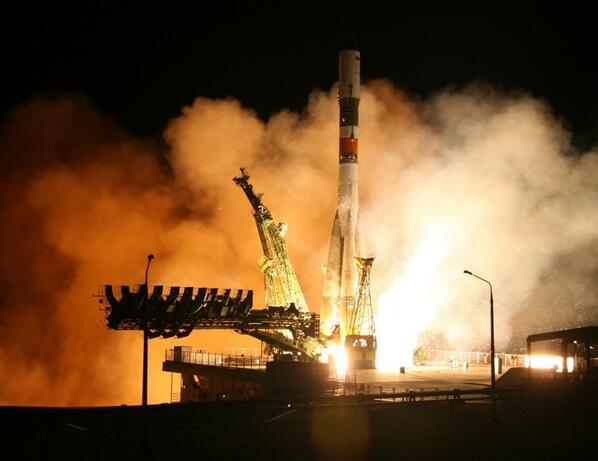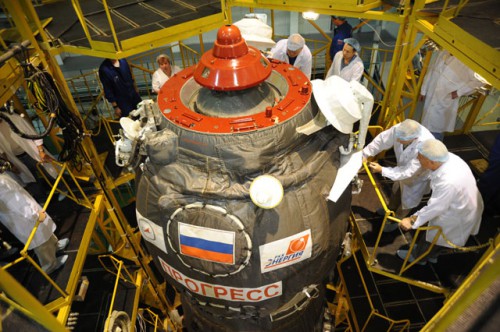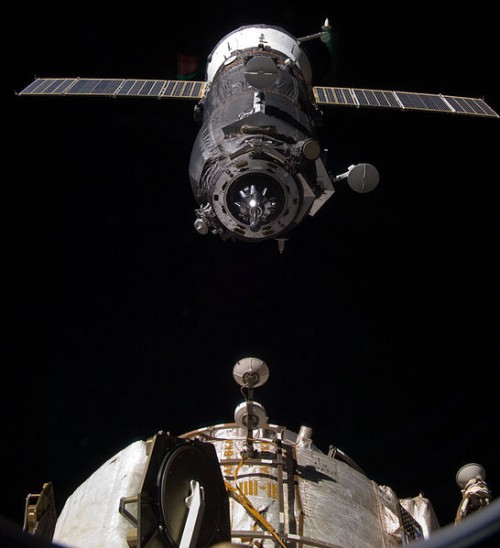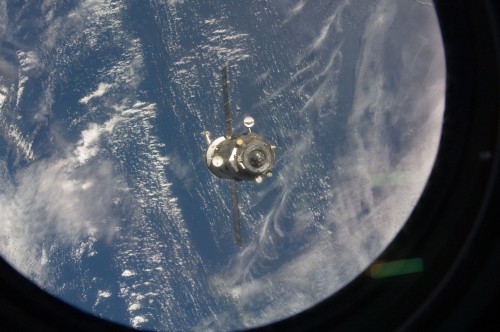
Russia has successfully launched its 53rd Progress resupply craft toward the International Space Station (ISS), carrying 5,285 pounds (2,398 kg) of payload and consumables to the Expedition 38 crew. Liftoff of Progress M-21M—also known as “Progress 53P” in ISS Program-speak—from Site 31/6 at the Baikonur Cosmodrome in Kazakhstan took place on time at 2:53 a.m. local time Tuesday, 26 November (3:53 p.m. EST Monday). At the time of writing, the spacecraft had successfully separated from the third stage of the rocket and was beginning a two-day flight profile to rendezvous with the ISS. It will evaluate the new Kurs-NA (“Course”) navigation system before retreating to a distance of about 250 miles (400 km), then re-rendezvousing with the space station, and finally docking at the aft longitudinal port of the Zvezda module late Friday evening.
Processing of this mission has gone exceptionally smoothly, and the tanks for Progress’ maneuvering thrusters were loaded with nitrogen tetroxide and unsymmetrical dimethyl hydrazine propellants and high-pressure helium. Last Thursday, the spacecraft was transferred to Baikonur’s Launcher Integration Building for installation atop the rocket—a direct descendent of Sergei Korolev’s R-7 missile—and the complete vehicle was rolled out to the Site 31/6 launch complex on Saturday, 23 November.
Fueling with liquid oxygen and rocket-grade kerosene (known as “RP-1”) concluded shortly before today’s liftoff and transitioned into a topping-off mode, whereby all cryogenic boil-off was rapidly replenished. This ensured that the liquid oxygen tanks were maintained at Flight Ready levels, ahead of the ignition of the single first-stage engine and the engines of the four tapering strap-on boosters. Internal avionics were initiated and on-board flight recorders were spooled-up to monitor the vehicle’s myriad systems. At T-10 seconds, the turbopumps on the core and strap-on boosters came to life and the engines were confirmed to be running at full power, producing a retraction of the fueling tower and a perfect, on-time launch into the darkened Baikonur sky. Fifteen seconds after liftoff, as noted by AmericaSpace’s Launch Tracker, a pitch and roll maneuver was completed, placing the vehicle onto the correct trajectory to insert Progress M-21M into orbit.

Rising rapidly, the vehicle passed 1,100 mph (1,770 km/h) within a minute of liftoff, during which time the maximum amount of aerodynamic stress (known as “Max Q”) impacted the vehicle’s airframe. At T+118 seconds, at an altitude of about 28 miles (45 km), the four strap-on boosters exhausted their supply of liquid oxygen and rocket-grade kerosene (RP-1) and were jettisoned, leaving the central core and its single engine to continue the ascent. By two minutes into the flight, the rocket was traveling at over 3,350 mph (5,390 km/h). The payload shroud and escape tower were jettisoned shortly afterward, and, some four minutes and 47 seconds after leaving Baikonur, the core separated at an altitude of 105 miles (170 km) and the third and final stage ignited to boost Progress M-21M to a velocity in excess of 13,420 mph (21,600 km/h). By the time the third stage separated, nine minutes into the flight, at 3:02 a.m. Baikonur time Tuesday (4:02 p.m. EST Monday), the vehicle was in space.
Separation of the Progress was scheduled to take place into a target orbit of approximately 120 x 152 miles (193 x 245 km), inclined 51.6 degrees to the equator, and the process of unfurling its solar arrays and Kurs rendezvous and navigational appendages got underway. Unlike several earlier Progresses—which, like recent piloted Soyuz craft have pursued six-hour, four-orbit “fast rendezvous” profiles—this current mission is unusual in that it will actually spend around four days and 65 orbits in flight before docking. The reason for the lengthy rendezvous is linked to tests of the new Kurs-NA navigation system, which boasts improved performance characteristics, reduced weight, and more efficient power consumption. It was first flown aboard Progress M-15M last year with mixed results.

“The spacecraft will perform three rendezvous burns on November 25 and 26 to link up with ISS for a rendezvous test on November 27,” Spaceflight101 noted. “Being equipped with the new Kurs-NA system, teams require the spacecraft to perform a close approach to ISS, but safely fly past the station, so that the performance of the new navigation system can be assessed.” In the aftermath of the test, Progress M-21M will retreat to a distance of about 250 miles (400 km), then execute three further burns to re-rendezvous with the ISS, ahead of docking with the Zvezda service module, at the station’s aft longitudinal port, at 5:28 p.m. Friday, 29 November (4:28 a.m. Baikonur time Saturday).
Progress M-21M will deliver 5,285 pounds (2,398 kg) of payload to the multi-national Expedition 38 crew, which consists of Russian cosmonauts Oleg Kotov, Sergei Ryazansky, and Mikhail Tyurin, Japan’s Koichi Wakata, and NASA astronauts Mike Hopkins and Rick Mastracchio. The supply ship’s pressurized compartment houses 2,770 pounds (1,260 kg) of dry cargo, including systems maintenance hardware, hygiene equipment, food provisions, medical supplies, and personal protection and emergency equipment. Also aboard the craft are science experiments and EVA equipment, presumably to support a planned spacewalk on around 20 December by Kotov and Ryazansky. The Progress will also deliver 1,480 pounds (670 kg) of propellant and is slated to perform a periodic “re-boost” of the space station’s orbital altitude in mid-December.
This mission marks the first visiting vehicle of the Expedition 38 increment, which officially began on 10 November, with the departure of Expedition 37 crew members Fyodor Yurchikhin, Karen Nyberg, and Luca Parmitano. Plans envisage that Progress M-21M will remain docked at the Zvezda aft port until 11 June 2014, whereupon it will separate and perform a destructive re-entry in the upper atmosphere. Further Progresses are slated for launch in February, April, July, and October 2014.

Progress has a storied history. Its development began in 1973 in response to the anticipated problem of resupplying and refueling the Soviet Union’s Salyut 6 space station, whose cosmonauts went on to spend more than six months at a time in orbit. Modeled closely on the Soyuz spacecraft, its interior was redesigned to house foodstuffs, water, experiments, and fuel for the station’s manoeuvring thrusters. Since its maiden voyage, Progress has seen many changes, but its role has remained largely unchanged … and the numbers speak for themselves. Between its first launch in January 1978 and today’s flight, no fewer than 144 Progresses have roared aloft. Only one has failed to reach its destination: the unlucky Progress M-12M in August 2011, whose launch vehicle suffered an engine malfunction and re-entered the atmosphere to destruction over the Altai region.
Writing in 1998, astronaut Jerry Linenger—one of the handful of U.S. astronauts to reside aboard Russia’s Mir space station—recounted the sheer joy of receiving a Progress-delivered shoebox full of goodies from his wife and children. “Once found, and munching on fresh apples that had also arrived in the Progress,” he described in his memoir, Off the Planet, “we individually retreated from our work and sneaked off to private sections of the space station, eager to peruse the box’s contents.” Fellow astronaut John Blaha once described similar excitement. “Once we found our packages,” he wrote, “it was like Christmas and your birthday, all rolled together, when you are five years old. We really had a lot of fun reading mail, laughing, opening presents, eating fresh tomatoes and cheese.” In more recent times, ISS crew members have done much the same. In February 2008, Peggy Whitson, commander of Expedition 16, remembered crewmate Dan Tani calling one Progress “the onion express,” as the latest delivery of letters from home and fresh foodstuffs arrived.
In their book Soyuz: A Universal Spacecraft, David Shayler and the late Rex Hall speculated that the term “Progress” may have originated from the implication of having made significant progress in space station operations, although the precise heritage of the name remains unclear. What is clear, though, is that aside from the technical and functional role of Progress over the decades, it has provided an indispensable psychological crutch for dozens of cosmonauts and astronauts—a crutch which has enabled them to overcome the profound isolation of the strange microgravity environment, far from family and friends.
Want to keep up-to-date with all things space? Be sure to “Like” AmericaSpace on Facebook and follow us on Twitter: @AmericaSpace



